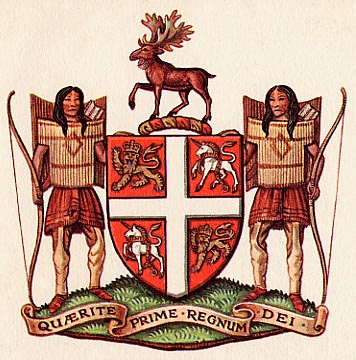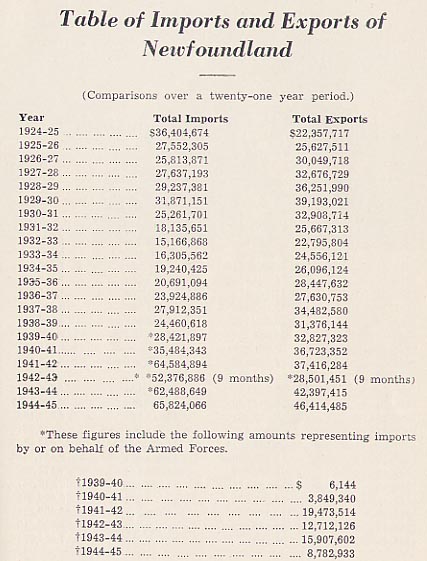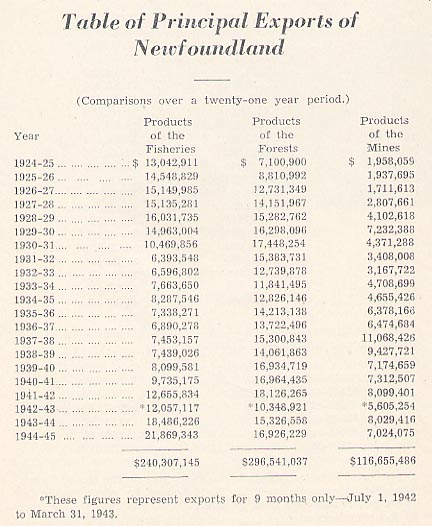
History

 |
Newfoundland History |
 |
External Trade of Newfoundland
(to 1949)
[This text was written in 1949. For the full citation, see the end of the text. Further information can be gathered by accessing this site.]
Though Newfoundland is often thought of as a one-industry country, and though the fisheries do occupy a large proportion of the population, fishery products at present account for only about one-third of the island's exports.

Exports in 1947-48 amounted to $77,839,000, an all-time record and more than double the amount for 1938. For the ten-year period, exports and imports may be tabulated thus, in thousands of dollars
Year Exports Imports 1938 34,483 27,712 1940 32,827 28,422 1942 37,416 64,539 1944 42,397 62,485 1946 61,012 65,895 1948 77,839 105,059
Exports in 1947-48 were to the United States, United Kingdom, Canada, and other countries, in this ratio - 26 to 13.5 to 9.5 to 28.5 - and consisted of the following commodities:
Salt codfish 20.9% Other fishery products 15.1% Minerals 19.6% Newsprint and Newspapers 32.0% Other forest products 6.9% Other products 2.2% Re-exports 3.3%

Imports during the same period were from Canada, United States, United Kingdom, and other countries in this ratio - 55 to 40.5 to 6 to 3.5 - and consisted of the following commodities:
Foodstuff and beverages 31.6% animal and vegetable products 6.0% textiles and clothing 11.3% wood and paper 5.0% non-metallic minerals 12.8% metals and manufactures 7.1% machinery and vehicles 17.6% chemicals and allied products 3.5% other products 5.1%
Foodstuffs and beverages, the largest class of imports, amounting altogether to $33,199,000, may be tabulated thus:
Flour, meal, grains 19.3% Vegetables 4.8% Fruit and juices 6.3% Fresh meats 7.3% Preserved meats 18.6% Sugar and products 13.3% Milk and products 7.0 Oils and fats, edible 6.3% Tea, coffee, cocoa 6.3% Wines, liquor, beer 4.5% Other 6.3%
Canada has been the largest supplier of Newfoundland's imports but has absorbed relatively few of the exports, since most of Newfoundland 's exports have been competitive with Canadian products. Ordinarily Newfoundland has had a small favourable trading balance with the United Kingdom, and a strongly favourable balance with her principal fish markets: Puerto Rico, Portugal, Italy, Jamaica, and Brazil. Since the development of the pulp-and-paper industry, the highly adverse balance with the United States has been reduced.
For a general account of the subject, see chapter VI of R. A. MacKay, Newfoundland : economic, diplomatic, and strategic studies (Toronto, 1946). For recent figures, see Canada, Dept. of trade and commerce, Foreign Trade, Feb. 12 and April 2, 1949.
Source: W. Stewart WALLACE, ed., The Encyclopedia of Canada . Newfoundland Supplement , Toronto, University Associates of Canada, 1949, 104p., pp. 96-98.
© 2004 Claude Bélanger, Marianopolis College |